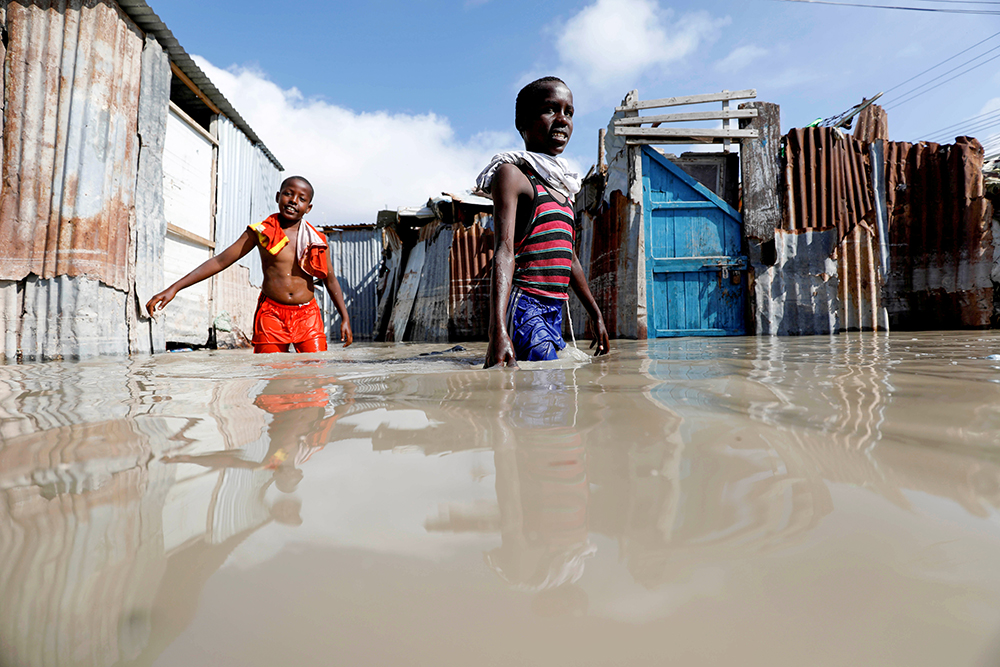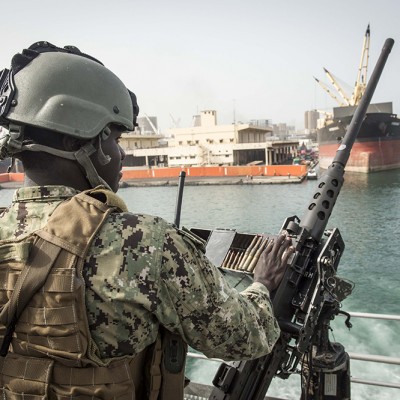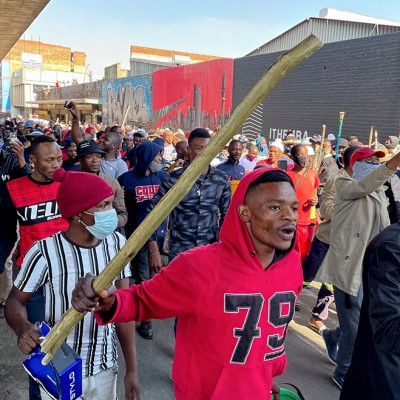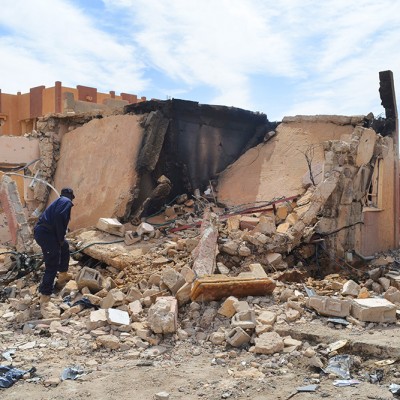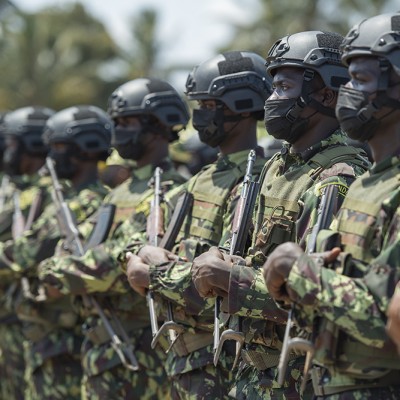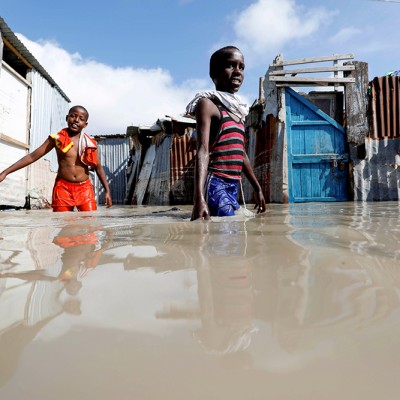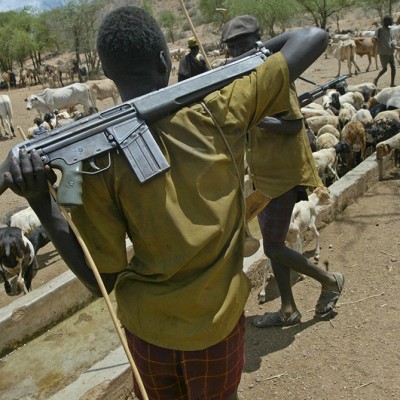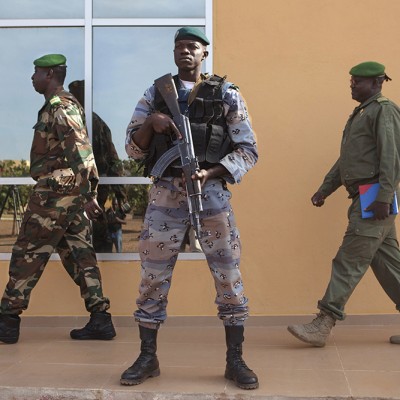Introduction
The effects of climate change are felt globally in frequent and severe disasters, increasing temperatures, and changing rainfall, with significant implications for society. Climate security acknowledges that climate change can undermine peace and increase levels of violence by affecting the drivers of conflict.[1]
Somalia, South Sudan, and Mali are all exposed to climate change, face complex security challenges, and host large peacekeeping forces. Increasing temperatures, changing rainfall patterns, droughts, and floods have disrupted livelihoods and forced migration in three African countries. Climate change contributes to farmer-herder competition over land and water. Elites take advantage of climate-related disruptions by exploiting marginalised groups, as do armed groups seeking to recruit youth.
The relationship between climate change and insecurity has been recognised in multilateral organisations with a mandate in climate, peace and security (CPS) in Africa. The United Nations Security Council (UNSC) has included climate security-specific language in country situation and peacekeeping mission resolutions, which has led to the creation of an Environmental Security Advisor position in the UN Assistance Mission in Somalia (UNSOM).[2] The African Union (AU) is advancing analysis and responses to CPS across Africa, including in high-level fora and in coordination with Regional Economic Communities (RECs).[3] The European Union (EU) is a global leader in development aid and climate finance, and several of its Member States have been instrumental in international climate diplomacy and CPS discussions.[4]
This article[5] discusses climate change and conflict and describes a risk-based approach to investigating links between the two.[6] It further outlines relevant climate data and context-specific climate vulnerabilities in Somalia, South Sudan, and Mali and analyses five themes in CPS in the three countries. The article concludes with recommendations for institutional responses. The research is based on a review of academic literature and institutional reports. Early versions of case studies formed the basis of consultations with government ministries, thematic experts, and CPS practitioners.[7]
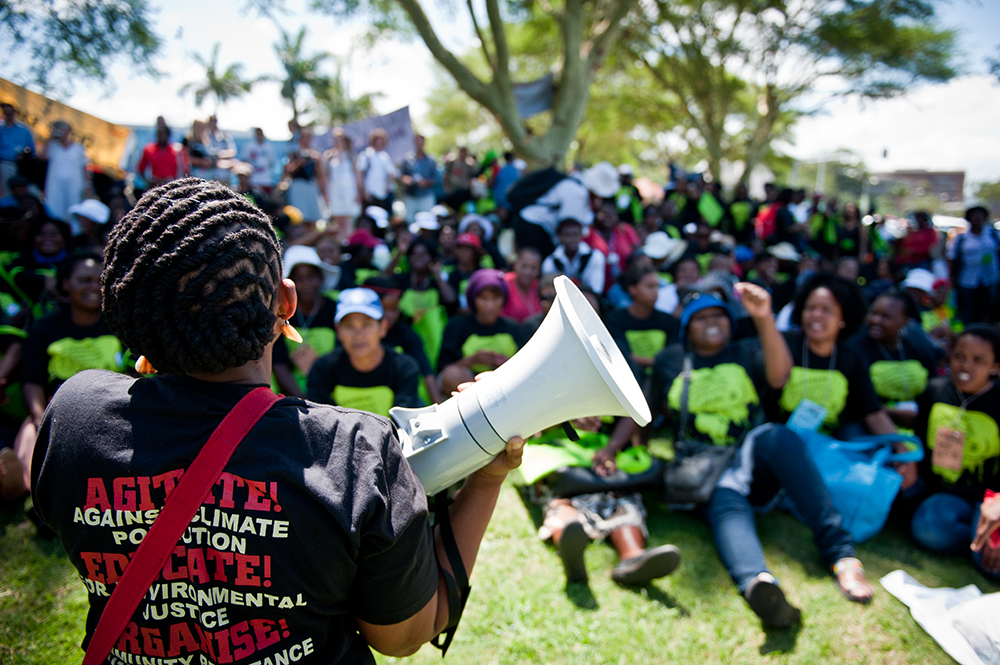
Climate Change, Peace and Security
There is clear evidence that the effects of climate change undermine human security, but the relationship between climate change, peace and security is contentious. Empirical studies on direct links between climate change and conflict have had mixed results, leading experts to caution against overstating the relationship between the two. Research presenting complex environmental, socioeconomic, and political processes as simple causality can mask the root causes of conflict, and depoliticise conflict analyses, resolution, and peacebuilding.[8]
Investigating climate-related security risks (CRSRs) is an alternative to relying on claims that climate change directly causes violent conflict. This approach analyses how the effects of climate change on human security can affect peace and security. CRSR focuses on when and under what circumstances climate change increases the risk of insecurity, drawing attention to contextual factors that define human security and the security outcomes of climate change.[9]
Research on CRSR in East and West Africa and South and South-East Asia has identified four interrelated pathways by which the physical effects of climate change can increase the risk of conflict: livelihood deterioration; changing migration and mobility; armed group tactics; and exploitation and mismanagement by elites.[10]
Local Climate Vulnerabilities
Somalia, South Sudan, and Mali are ranked among the countries most affected by climate change and disasters in measures that include physical exposure to hazards and resilience and coping capacity for managing climate-related threats.[11] All three countries are also affected by complex conflict situations and host some of the largest peacekeeping forces worldwide.[12]
This section examines how the physical effects of climate change interact with socioeconomic and political factors, combining current and projected climate data with context-specific socio-ecological vulnerabilities that accentuate the physical effects of climate change on peace and security.[13]
Somalia
Extreme weather events and disasters have occurred more frequently in Somalia in the past 25 years, while political instability and violent conflict have simultaneously undermined local and national capacities to respond. Somalia has experienced a 1°C to 1.5°C increase in median annual temperatures since 1991 and could warm by 2.5°C by 2050.[14] A 3% increase in precipitation is projected by 2050, with more variable seasonal rainfall that may benefit agriculture in some regions but lead to flooding and soil erosion in others.[15]
High dependence on renewable natural resources makes much of the Somali population vulnerable to the impact of climate change on temperatures and rainfall. Conflict and disasters have displaced around 2.9 million people, negatively affecting their coping capacities.[16] Relief operations and development programmes face challenges in accessing territory under the control of armed groups like Al Shabaab, while conflict between political factions in the federal government and federal member states undermines institutional capacities to respond to the effects of climate change.
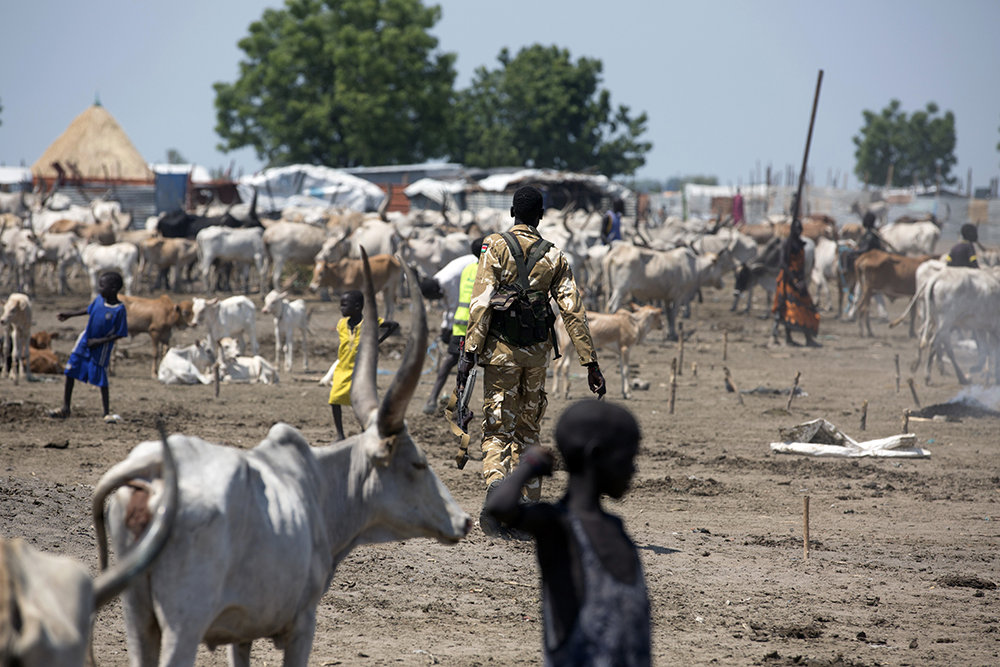
South Sudan
South Sudan is vulnerable to climate change and disasters, worsening existing humanitarian crises and the fragile security environment. Mean annual temperatures vary between 26°C and 32°C and have increased by over 0.4°C every decade for the last 30 years.[17] Average temperatures are projected to increase between 0.8°C and 1.7°C by 2060.[18] Rainfall is becoming more erratic, with some regions experiencing more rainfall and flooding and others less rain and longer dry seasons.[19] South Sudan is projected to become warmer and drier, with more frequent intense downpours, increasing the risk of flooding.
Eleven million people depend on agriculture, fishing, and forest resources in South Sudan, which are heavily reliant on seasonal rainfall.[20] Political and economic instability have undermined livelihoods and food security.[21] Oil extraction, deforestation, and charcoal production are driven by local energy needs and national dependency on oil revenues, but resulting environmental degradation and soil erosion increase the physical effects of climate change and disasters.[22]
Mali
The effects of climate change differ across Mali’s ecological zones, while violent conflict is increasingly concentrated in the central Sahelian zone. Average national temperatures increased by 0.7°C between 1960 and 2015 to 28.3°C and are projected to increase by between 1.2°C and 3.6°C by 2060, particularly affecting the southwest, central, and northern areas.[23] Precipitation is becoming more erratic, a trend that is expected to continue, increasing the risk of droughts and floods in exposed areas.[24]
Mali’s population is also heavily reliant on agriculture and agro-pastoralism and vulnerable to changing rainfall patterns and increasing temperatures. More than 300 000 people, of which 56% are women, have been displaced by violent conflict involving multiple Salafi Jihadist groups and community militias.[25] Land and water disputes between herders and farmers increasingly overlap with conflicts between ethnic communities, armed groups and the government, making local resource conflicts more complex and violent.
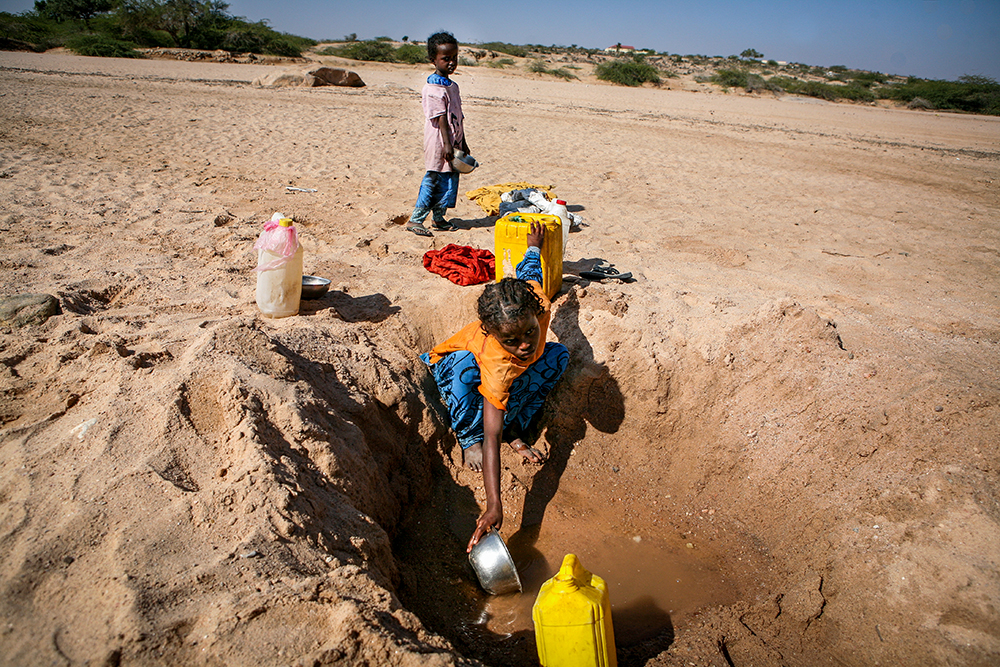
Somalia, South Sudan, and Mali: Trends in Climate-Related Security Risks
The physical effects of climate change in Somalia, South Sudan, and Mali interact with context-specific vulnerabilities to increase the risk of insecurity. This section highlights five common themes, including livelihoods, migration, and farmer-herder conflict; overlapping conflict dynamics; the operations of Salafi Jihadist groups; the gendered impacts of CRSR; and the role of governance.
Livelihoods, Migration and Farmer-herder Conflicts
Livelihoods that depend on natural resources are most vulnerable to the effects of climate change. Agriculture, pastoralism, and fishing support over 80% of the population in the three countries.[26] Livelihood insecurity is accentuated by poverty, violent conflict, and weak governance, so the effects of climate change on temperatures, rainfall, and disasters can leave people with limited income alternatives.
Affected groups sometimes cope with livelihood insecurity by migrating to areas with better resource availability. However, there is evidence that this can increase the risk of conflict, particularly when changing migration patterns intensify resource use and increase farmer-herder competition over access to land and water. Community leaders in Somalia report that droughts fuel conflict between settled farmers and migrant herders over access to natural resources.[27] In South Sudan, severe flooding in 2020 forced pastoralists in Jonglei, the Eastern Lakes, and Terekeka to migrate along new routes in Equatoria, increasing tensions with locals.[28] In Mali’s Inner Niger Delta, intensive upstream water use and rainfall deficits have increased farmer-herder competition over water and pastures.[29]
There is evidence that farmer-herder disputes are becoming more frequent and violent. Increasing temperatures and erratic rainfall have diminished natural resources needed for agriculture and pastoralism, and changing migration patterns have driven pastoralists into new regions and concentrated resource users into smaller areas. Iniquitous government policies have accentuated intra-group tensions, while political violence has undermined social cohesion and trust between clans in Somalia, ethnic groups in South Sudan, and ethnoreligious communities in Mali.
Intersecting Local and National Conflicts
The effects of climate change on resource users have sometimes increased the risk of local conflicts. However, climate change can also indirectly feed national and even regional conflicts when armed groups and powerful elites capitalise on local vulnerabilities. These cases are context-specific and reflect differing conflict dynamics in the three countries.
Poor rains, flash floods and water shortages displace thousands of people in Somalia annually.[30] In June 2019, several years of drought, widespread crop failure, and reduced livestock profitability displaced 53 000 people.[31] In some cases, large-scale displacement changed the political balance of the host community and threatened the control of dominant groups, leading to tension and violence.[32]
In South Sudan, 74% of households own livestock.[33] Climate change can exacerbate livestock-related tensions by affecting pasture and water resources, and increasing the risk of livestock raiding, looting and communal conflict.[34]CRSRs are salient in regions with varied grazing and water availability and existing ethnic tensions, such as in the Sudd wetland. They are also heightened by elites’ exploitation of the livestock sector.[35] Elites have amassed large cattle herds and they play a role in livestock-related conflicts, for example, by mobilising armed herders in a show of power.[36] As elite involvement inflates livestock prices, young men increasingly join armed groups to obtain cattle as loot or through elite patronage.
In Mali, expanding violent conflict has led to an overlap between local resource disputes and national conflict dynamics. This has escalated levels of community violence and increased the involvement of armed groups in local resource disputes, making land and water conflicts more deadly and harder to resolve. In central Mali, self-defence militias in farming Dogon and herding Fulani communities have grown exponentially along with the availability of small arms, which have increased the levels of inter-communal violence.[37]
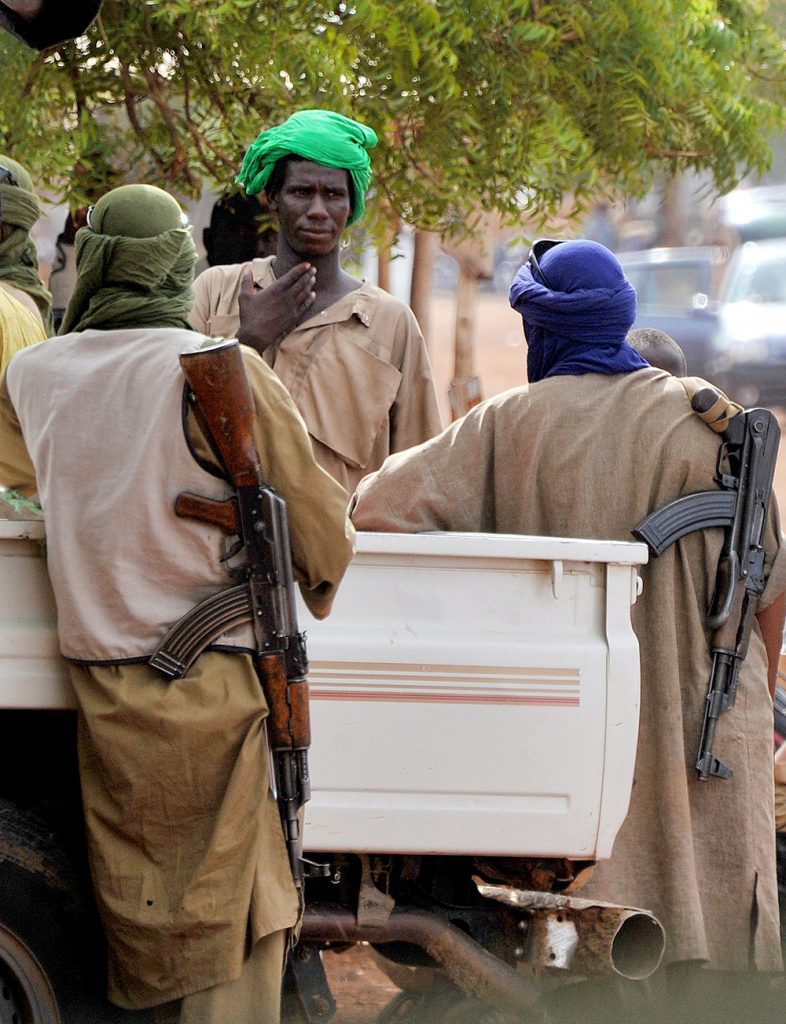
Salafi Jihadist Groups
Salafi Jihadist groups like Al Shabaab and Katiba Macina/Macina Liberation Front (KM) in Somalia and Mali have used the effects of climate change to build support, boost recruitment, and advance their operations. Government absence creates a power vacuum where these groups have stepped in to provide support and alternative governance to local communities, including in cases where climate-related stress undermines livelihood security.
Studies in Somalia show that droughts and the resulting livelihood deterioration force pastoralists to sell off livestock, depressing prices and creating local economic shocks. Groups such as Al Shabaab offer economic support to communities who are negatively affected by climate-related livelihood shocks or people who have been displaced by droughts and conflict. Al Shabaab has also presented itself as a service and relief provider during droughts in areas outside of government control.[38]
KM is active in central Mali, where they have used local vulnerabilities, including iniquitous land rights and the marginalisation of Fulani herders, to draw local support and recruits. KM and other groups that control territory in north and central Mali have established themselves as resource dispute mediators, provided protection and material support to farmers and herders, and managed seasonal livestock migration.[39]
The Gendered Impacts of Climate-related Security Risks
Climate change and conflict have a significant effect on women and girls in Somalia, South Sudan, and Mali. Women’s traditional roles in the household, childcare, and care for the elderly can mean that their vulnerability has cascading effects on community resilience.
Male migration is an adaptation strategy that increases the vulnerability of female-headed households to poverty, exploitation and violence. In Somalia, men migrate for longer periods during droughts in search of water for livestock or alternative income sources, but female relatives usually stay behind. In South Sudan, women typically support their families with farming, relying heavily on natural resources, while men and boys manage livestock and can migrate or join cattle raids and armed groups when their livelihoods are jeopardised. Women and girls who are displaced by disasters and conflict are more exposed to violence.[40]
Traditional gender roles and inequalities mediate the effects of climate change on men and women. Structural disadvantages include education gaps, child marriage, low social status, and restricted access to financial resources and assets, including land. In South Sudan, some 87% of female household heads have no formal education, compared to 65.7% of their male counterparts, which affects the resilience of female-headed households (for example, child malnourishment is more prevalent in female-led families).[41] Women comprise 40% of the agricultural workforce in Mali but represent less than 10% of landowners, even though national legislation protects and promotes female land ownership.[42] Many women depend on small-scale agriculture and small livestock for sale in local markets, making them vulnerable to the effects of climate change and conflict on natural resources and local economies.
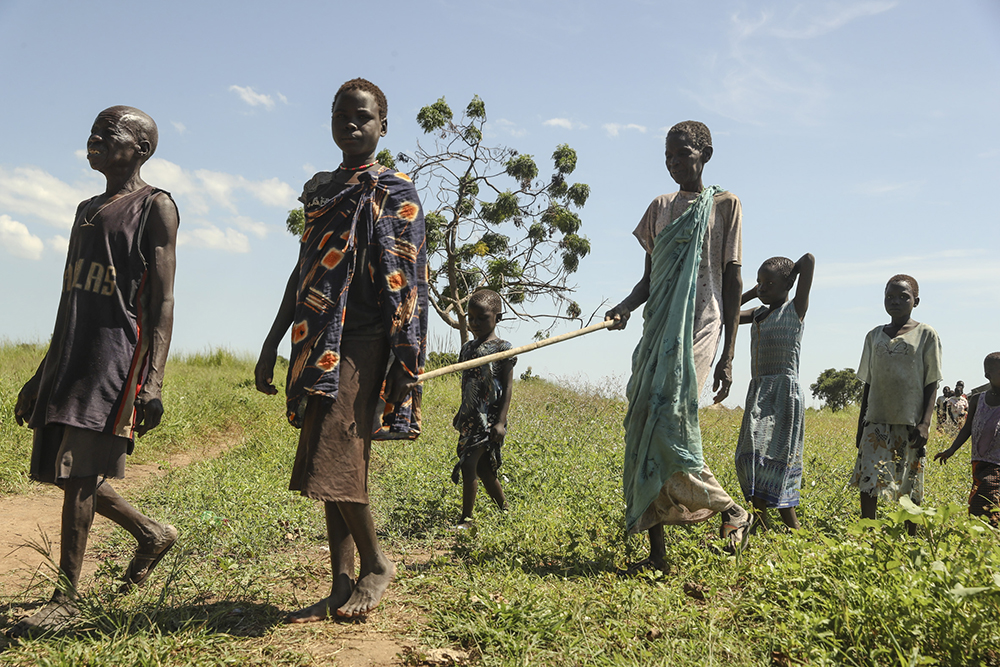
The Importance of Good Governance
The presence and legitimacy of institutions (formal, informal or traditional) can mediate the effects of climate change and conflict on local communities. Conversely, elite exploitation or mismanagement accentuates vulnerabilities and inequalities and increases the risk that climate change feeds conflict.
In Somalia, local and national elites and clans use droughts, floods, and even locust infestations to strengthen control over resources at the expense of weaker groups.[43] Elites also use climate impacts to gain support for their political agenda by fuelling inter-group grievances and resentment towards the Federal Government of Somalia and its allies.[44] The manipulation of clan relations and exploitation of clan grievances and marginalised groups increase the risk that local conflicts will interact with national politics and escalate further.
In South Sudan, human activities accelerate environmental degradation and accentuate the impact of climate change and the severity of disasters. While most livelihoods depend on natural resources, about 90% of government revenue comes from oil reserves.[45] Herders in oil-rich Unity state have lost grazing lands to the operations of oil companies, and the environmental impacts of oil exploitation have degraded remaining pasture and water resources.[46] This increases the risk that climate change accentuates marginalisation, feeds grievances and fuels conflicts.
Weak governance has accentuated the effects of climate change in Mali. National agricultural policies have prioritised sedentary agriculture over migrant pastoralism, restricting herders’ access to land and water and increasing resource competition in the Inner Niger Delta and Sikasso region.[47] Local government corruption has sometimes led farmers and herders to use self-defence rather than judicial courts in protecting their land and water access.[48]
The projected effects of climate change on temperatures, rainfall, and the frequency and intensity of natural disasters in the three countries interact with a wealth of context-specific realities, institutions, and dynamics. This article highlights common trends, but also shows that climate security vulnerabilities differ across and within countries. It further shows that climate change amplifies existing vulnerabilities and accentuates prevailing inequalities, increasing the risk of violence and conflict, and undermining peacebuilding efforts.
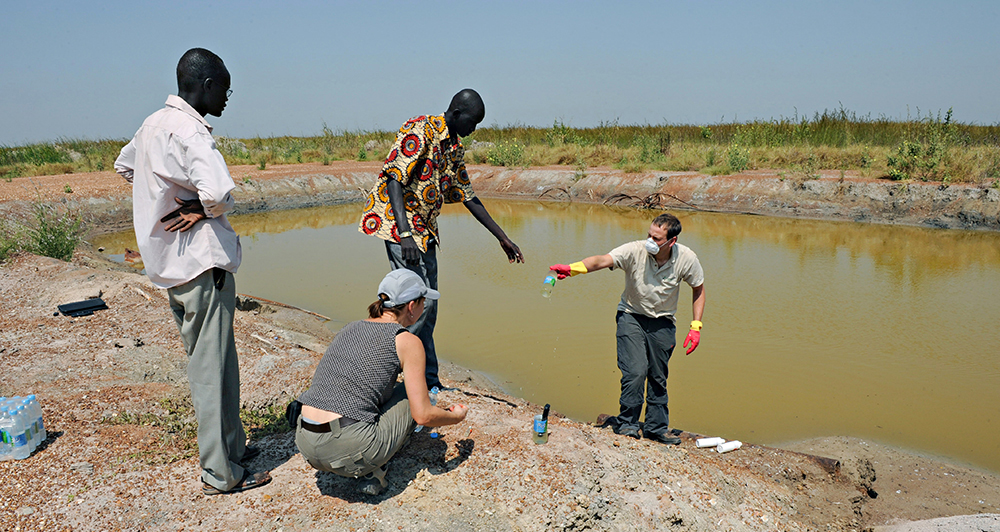
Conclusions and Recommendations
The trends in climate security identified in Somalia, South Sudan, and Mali highlight three factors. First, CRSR does not affect all groups equally because of local differences in adaptive capacities. Marginalised groups bear the brunt of physical climate change and the direct and indirect violence it engenders. Second, conflict is not an inevitable consequence of climate change and identifying context-specific social, political, and economic vulnerabilities and strengths is key to building resilience to CRSR.[49] Research can contribute to this by further examining how disasters can increase social cohesion and strengthen cooperation between conflict parties. Third, the context-specificity of CRSR poses a challenge to institutions with a mandate in CPS. These factors highlight areas where efforts to limit the effects of climate change on peace and security should be targeted in Somalia, South Sudan, and Mali. Four of these areas are described below.
Women should be at the centre of climate action
Governments should work with local stakeholders, particularly women’s organisations, to include women in decision-making on conflict-sensitive climate adaptation. Working with research institutions, including national universities, can support the aim of gathering data on how climate change and conflict affect women and girls.
Governance is central to the pathways from climate change to conflict
Exploitation and mismanagement accentuate the effects of climate change on affected communities, reduce resilience, and increase the risk of conflict. To improve governance, governments and community leaders should work to understand the socio-ecological impacts of climate change better as well as the specific vulnerabilities of marginalised groups. Special attention should be paid to natural resource management and how existing practices and structures can be transformed to increase cooperation and strengthen livelihood security.
Early warning systems and data analysis capacities are critical to preventive action
Organisations should invest in new tools or improve existing tools for pre-empting CRSRs. Human resources, including environmental security advisors, can build the capacity of organisations like the UN, AU, and EU to analyse, report, and respond to CRSRs in climate-exposed and conflict-affected countries. They can also facilitate cross-organisation information-sharing, reinforcing the links between development, humanitarian and peacebuilding work, and thematic agendas such as countering violent extremism and the inclusion of women and youth.
Climate change and environmental degradation should be factored into conflict analyses and peacebuilding efforts. Climate-sensitive approaches to peacebuilding cannot be a one-size-fits-all approach for conflict-affected regions. Climate-sensitive peacebuilding should be context-specific and consider the particular vulnerabilities of groups, including women and youth. An environmental advisor can support climate-sensitive conflict analyses and peacebuilding that factors in the effects of climate change and environmental degradation into the root causes of violence.
As climate change and conflict continues in Somalia, South Sudan, and Mali, new risks may emerge. Understanding current manifestations of CRSR and the range of possible responses can help policymakers to respond timeously to such risks.
Kheira Tarif is a Research Assistant in the Climate Change and Risk Programme at the Stockholm International Peace Research Institute (SIPRI).
Anab Ovidie Grand is a Junior Research Fellow with the Norwegian Institute of International Affairs (NUPI) working on the Training for Peace (TfP) programme, the Effectiveness of Peace Operations Network (EPON), and the Climate-related Peace and Security Risks (CPSR) project.
Endnotes
[1] Von Uexkull, Nina and Buhaug, Halvard (2021) ‘Security Implications of Climate Change: A Decade of Scientific Progress’, Journal of Peace Research, 58(1), 3–17.
[2] Resolution 2349 (2017) on the Lake Chad Basin Region was the first to recognise that climate change can accentuate regional instability. The 2021 mandate renewal of the UN Mission in South Sudan (Resolution 2514) recognises the adverse effects of climate change on the humanitarian situation and stability.
[3] De Coning, Cedric; Krampe, Florian; and Grand, Anab O. (2021) ‘The Impact of Climate Change on Africa’s Peace and Security’, Training for Peace, Available at: https://trainingforpeace.org/analysis/the-impact-of-climate-change-on-africas-peace-and-security [Accessed 26 July 2021].
[4] Lazard, Olivia and Youngs, Richard (2021) ‘The EU and Climate Security: Toward Ecological Diplomacy’, Carnegie Europe, Available at: https://carnegieeurope.eu/2021/07/12/eu-and-climate-security-toward-ecological-diplomacy-pub-84873 [Accessed 26 July 2021].
[6] The authors would like to thank Cedric de Coning (NUPI), Emilie Broek, Karolina Eklöw, and Katongo Seyuba (SIPRI) for reviewing this article.
[7] NUPI (2020) ‘Climate-related Peace and Security Risks (CPSR)’, Available at: https://www.nupi.no/nupi_eng/About-NUPI/Projects-centers/Climate-related-Peace-and-Security-Risks [Accessed 27 July 2021].
[8] Böhmelt, Tobias; Bernauer, Thomas; Buhaug, Halvard; Gleditsch, Nils; Tribaldos, Theresa; and Wischnath, Gerdis (2014) ‘Demand, Supply, and Restraint: Determinants of Domestic Water Conflict and Cooperation’, Global Environmental Change, 29, 337–348; Hsiang, Soloman M.; Burke, Marshall; and Miguel, Edward (2013) ‘Quantifying the Influence of Climate on Human Conflict’, Science, 341(6151), 1235367; Urdal, Henrik (2005) ‘People vs. Malthus: Population Pressure, Environmental Degradation, and Armed Conflict Revisited’, Journal of Peace Research, 42(4), 417–434; Raleigh, Clionadh and Urdal, Henrik (2007) ‘Climate Change, Environmental Degradation and Armed Conflict, Political Geography, 26(6), 674–694.
[9] Mobjörk, Malin; Gustafsson, Maria-Therese; Sonnsjö, Hannes; van Baalen, Sebastian; Dellmuth, Lisa; and Bremberg, Niklas (2016) ‘Climate-related Security Risks: Towards an Integrated Approach’, SIPRI, Available at: https://www.sipri.org/sites/default/files/Climate-related-security-risks.pdf [Accessed 5 August 2021].
[10] Mobjörk, Malin; Krampe, Florian; and Tarif, Kheira (2020) ‘Pathways of Climate Insecurity: Guidance for Policymakers’, SIPRI, Available at: https://www.sipri.org/sites/default/files/2020-11/pb_2011_pathways_2.pdf [Accessed 5 August 2021].
[11] Notre Dame Global Adaptation Initiative (ND-GAIN) (n.d.) ‘ND-GAIN Country Rankings’, ND-GAIN, University of Notre Dame, Available at: <https://gain.nd.edu/our-work/country-index/rankings> [Accessed 26 July 2021]; Disaster Risk Management Knowledge Centre (DRMKC) (n.d.) ‘EU Inform Risk Index’, DRMKC, European Commission, Available at: https://drmkc.jrc.ec.europa.eu/inform-index/INFORM-Risk [Accessed 26 July 2021]. Note: the ND-GAIN Country Index for Sudan covers Sudan and South Sudan.
[12] Krampe, Florian (2019) ‘Climate Change, Peacebuilding and Sustaining Peace’, SIPRI, Available at: https://www.sipri.org/sites/default/files/2019-06/pb_1906_ccr_peacebuilding_2.pdf [Accessed 26 July 2021].
[13] Moran, Ashley; Busby, Joshua; Raleigh, Clionadh; Smith, Todd G.; Kishi, Roudabeh; Krishnan, Nisha; and Wight, Charles (2018) ‘The Intersection of Global Fragility and Climate Risks’, September, United States Agency for International Development (USAID).
[14] Ministry of National Resources, Somalia (2013) ‘National Adaptation Programme of Action on Climate Change (NAPA)’, Republic of Somalia, Available at:https://unfccc.int/resource/docs/napa/som01.pdf [Accessed 26 July 2021].
[15] Ibid.
[16] UN High Commissioner for Refugees (UNHCR) Operational Data Portal (2021) ‘Horn of Africa Somalia Situation’, UNHCR, Available at: https://data2.unhcr.org/en/situations/horn/location/192 [Accessed 18 October 2021].
[17] Ministry of Environment, South Sudan (2016) ‘Republic of South Sudan’s National Adaptation Programme of Actions (NAPA) to Climate Change’, Republic of South Sudan, Available at: https://unfccc.int/files/adaptation/workstreams/national_adaptation_programmes_of_action/application/pdf/south_sudan_final_napa_-_24th_nov-2016.pdf[Accessed 16 July 2021]. Note: there is little available climate data for South Sudan. Most of the 43 South Sudan Meteorological Service stations were destroyed during the Second Sudanese Civil War.
[18] Quinn, Colin; Fox, Ashley; Baroang, Kye; Evans, Dan; Gomes, Melq; and Habib, Josh (2019) ‘South Sudan Climate Vulnerability Profile: Sector- and Location-specific Climate Risks and Resilience Recommendations’, USAID, Available at: https://www.climatelinks.org/sites/default/files/asset/document/USAID_The%20Cadmus%20Group_South%20Sudan%20Climate%20Vulnerability%20Profile%20to%20Improve%20Resilience.pdf [Accessed 26 July 2021].
[19] Ibid.
[20] UN Food and Agriculture Organization (FAO) (2020) ‘South Sudan Response Plan April 2020-March 2021’, FOA, Available at: http://www.fao.org/3/ca9762en/ca9762en.pdf [Accessed 26 July 2021].
[21] Ministry of Environment, South Sudan (2016) op. cit.
[22] UN Environment Programme (UNEP) (2018) ‘South Sudan: First State of Environment and Outlook Report 2018’, UNEP, Available at: https://wedocs.unep.org/bitstream/handle/20.500.11822/25528/SouthSudan_SoE2018.pdf?sequence=1&isAllowed=y [Accessed 26 July 2021].
[23] World Bank (n.d.) ‘Mali: Climate Data, Historical’, Climate Change Knowledge Portal, Available at: https://climateknowledgeportal.worldbank.org/country/mali/climate-data-historical [Accessed 27 July 2021].
[24] Niang, Isabelle; Mohamed, Chettibi; Ama, Essel; and Lennard, Chris (2014) ‘Africa’, In Dube, Pauline and Leary, Neil (Eds), Climate Change 2014: Impacts, Adaptation, and Vulnerability. Part B: Regional Aspects. Cambridge, UK: Cambridge University Press, pp. 1199–1265.
[25] Government of the Republic of Mali, International Organization for Migration (IOM), and UNHCR (2020) ‘Matrice de Suivi des déplacements (DTM) Mali’ [Mali Displacements Matrix], IOM, Available at: https://displacement.iom.int/system/tdf/reports/DTM_DECEMBRE_2020_0.pdf?file=1&type=node&id=10701 [Accessed 26 July 2021].
[26] World Bank (2020) ‘Employment in Agriculture’, World Bank, 29 January, Available at: https://data.worldbank.org/indicator/SL.AGR.EMPL.ZS [Accessed 27 July 2021]; Ministry of Foreign Affairs, Netherlands (2018) ‘Climate Change Profile, South Sudan’, ReliefWeb, Available at: https://reliefweb.int/sites/reliefweb.int/files/resources/South%2BSudan.pdf [Accessed 27 July 2021]; Government of the Republic of Mali (2016) ‘Contribution Determinée au niveau National’, UN Framework Convention on Climate Change (UNFCCC), Available at: https://www4.unfccc.int/sites/ndcstaging/PublishedDocuments/Mali%20First/Mali_revised%20NDC.pdf [Accessed 27 July 2021].
[27] Ministry of National Resources, Somalia (2013) op. cit.
[28] Tiitmamer, Nhial (2020) ‘South Sudan’s Devastating Floods: Why There is a Need for Urgent Resilience Measures’, Sudd Institute, Available at: https://www.suddinstitute.org/assets/Publications/5fbcef5b321bd_SouthSudansDevastatingFloodsWhyThereIs_Full.pdf [Accessed 27 July 2021].
[29] Madgwick, F. Jane; Oakes, Robert; Pearce, Fred; and Tharme, Rebecca E. (2017) ‘Water Shocks: Wetlands and Human Migration in the Sahel’, Wetlands International, Available at: https://programme.worldwaterweek.org/Content/ProposalResources/PDF/2017/pdf-2017-7965-1-Water%20Shocks_Wetlands%20International.pdf [Accessed 27 July 2021].
[30] UN Office for the Coordination of Humanitarian Affairs (OCHA) (2020) ‘Humanitarian Bulletin, Somalia, 1–31 December 2020’, ReliefWeb, Available at:https://reliefweb.int/sites/reliefweb.int/files/resources/Somalia_%20Humanitarian%20Bulletin_December%202020_Publication.pdf [Accessed 15 July 2021].
[31] State Minister for Environment, Office of the Prime Minister and Line Ministries and Ministry of Planning, Somalia (2015) ‘Somalia’s Intended Nationally Determined Contributions (INDCs)’, UNFCCC, Available at: https://www4.unfccc.int/sites/ndcstaging/PublishedDocuments/Somalia%20First/Somalia%27s%20INDCs.pdf [Accessed 15 July 2021].
[32] Eklöw, Karolina and Krampe, Florian (2019) ‘Climate-related Security Risks and Peacebuilding in Somalia’, SIPRI, Available at: https://www.sipri.org/publications/2019/sipri-policy-papers/climate-related-security-risks-and-peacebuilding-somalia [Accessed 30 July 2021].
[33] Quinn, Colin et al. (2019) op. cit.
[34] Ibid.
[35] Sosnowski, Amelia; Ghoneim, Eman; Burke, Jeri J.; Hines, Elizabeth; and Halls, Joanne (2016) ‘Remote Regions, Remote Data: A Spatial Investigation of Precipitation, Dynamic Land Covers, and Conflict in the Sudd Wetland of South Sudan’, Applied Geography, 69, 51–64.
[36] Idris, Iffat (2018) ‘Livestock and Conflict in South Sudan’, K4D Helpdesk report, 29 October, Available at: https://assets.publishing.service.gov.uk/media/5c6abdec40f0b61a22792fd5/484__Livestock_and_Conflict_in_South_Sudan.pdf [Accessed 15 July].
[37] Benjaminsen, Tor A. and Ba, Boubacar (2021) ‘Fulani-Dogon Killings in Mali: Farmer-Herder Conflicts as Insurgency and Counterinsurgency’, African Security, 24, 1–23.
[38] UN (2018) ‘UN Strategic Framework Somalia 2017-2020’, UNSOM, Available at: https://unsom.unmissions.org/un-strategic-framework-somalia-2017-2020-0 [Accessed 27 July 2021].
[39] Ba, Boubacar and Cold-Ravnkilde, Signe Marie (2021) ‘When Jihadists Broker Peace: Natural Resource Conflicts as a Weapon of War in Mali’s Protracted Crisis’, Danish Institute for International Studies, Available at: https://www.diis.dk/en/research/when-jihadists-broker-peace [Accessed 5 August 2021].
[40] Human Rights Watch (HRW) (2018) ‘World Report 2018 – Somalia’, HRW, Available at: https://www.hrw.org/world-report/2018/country-chapters/Somalia [Accessed 5 August 2021].
[41] Mai, Nyathon H; Jok, Jok M.; and Tiitmamer, Nhial (2018) ‘Climate Change and Gender in South Sudan’, Sudd Institute, 1 August, Available at: https://media.africaportal.org/documents/ClimateChangeAndGenderInSouthSudan_Full.pdf [Accessed 30 July 2021].
[42] Bouchama, Nejma; Ferranti, Gaëlle; Fuireti, Léa; Menesesi, Alejandra; and Thim, Annelise (2018) ‘Gender Inequality in West African Social Institutions’, OECD, 8 March, Available at: https://www.oecd-ilibrary.org/development/gender-inequality-in-west-african-social-institutions_fe5ea0ca-en [Accessed 23 July 2021].
[43] Majid, Nisar and McDowell, Stephen (2012) ‘Hidden Dimensions of the Somalia Famine’, Global Food Security, 1(1), 36–42.
[44] Ibid.
[45] African Development Bank (AfDB) (2021) ‘African Economic Outlook 2021: From Debt Resolution to Growth: The Road Ahead for Africa’, AfDB, Available at: https://www.afdb.org/en/documents/african-economic-outlook-2021 [Accessed 5 August 2021].
[46] Cormack, Zoe and Young, Helen (2012) ‘Pastoralism in the New Borderlands: Cross-border Migrations, Conflict and Peace-building’, Feinstein International Center, Available at: https://fic.tufts.edu/assets/Pastoralism-in-the-New-Borderlands.pdf [Accessed 23 July 2021].
[47] Marquette, Camille (2020) ‘Maintaining Peace and Stability in Mali’s Sikasso Region’, International Alert, Available at: https://www.international-alert.org/sites/default/files/Mali_MaintainingPeaceAndStability_EN_2020.pdf [Accessed 15 July 2021]; Benjaminsen, Tor A.; Alinon, Koffi; Buhaug, Halvard; and Buseth, Jill T. (2012) ‘Does Climate Change Drive Land-Use Conflicts in the Sahel?’ Journal of Peace Research, 29(1), 97–111.
[48] Benjaminsen, Tor A. and Ba, Boubacar (2009) ‘Farmer-herder Conflicts, Pastoral Marginalisation and Corruption: A Case Study from the Inland Niger Delta of Mali’, Geographical Journal, 175(1), 71–81.
[49] De Coning, Cedric (2021) ‘Strengthening the Resilience and Adaptive Capacity of Societies at Risk from Hybrid Threats’, European Centre of Excellence for Countering Hybrid Threats, Working paper no. 9, 1 June, Available at: https://www.hybridcoe.fi/wpcontent/uploads/2021/05/20210601_Hybrid_CoE_Working_Paper_9_Strengthening_the_resilience_and_adaptive_capacity_of_societies_WEB.pdf [Accessed 5 August 2021].

